Color us here at WrestleCrap surprised.
When Fandango’s vignettes began playing, ol’ RD was about to engrave the cha-cha dancer’s name onto the 2013 Gooker Award plaque well in advance. I myself have tallied many Power Crappings ballots that featured Johnny Curtis’ alter ego among the selections.
It seemed Fandango was destined for induction from the minute his, “Mind if I cut in?” promo first appeared on Raw.
But on two levels, inducting the Ballroom Brawler will now be impossible.
First off, there’s the gusto with which he plays the part. Watching him in action gives you the impression that he *is* Fandango, and not merely “Johnny Curtis in dance attire.” He lives Fandango, he breathes the role. He didn’t break stride in his appearance on Opie and Anthony’s radio show, leaving the second that the hosts failed to get his name right.
The length to which he lives the role was evident on Monday night, after Chris Jericho brutalized him with a flurried assault. When Fandango was announced the winner via DQ, the nearly-comatose dancer took the mic and, with gasping and pained breaths, insisted upon the actual pretentious pronunciation of his name.
That’s dedication to the role.
And speaking of that Monday night, as we all have seen and heard, the sarcastic and lively crowd hijacked the show via guerrilla chanting. Among the highlights of their assault on the staleness was 16,000 fans in East Rutherford “da-da-da’ing” Fandango’s theme song while rocking around like a goofy mosh pit.
As we speak, in an act of further good-natured culture jamming, fans are downloading Fandango’s catchy cha-cha theme off if iTunes and Amazon to see how far they can get it up the charts.
It’s neat to see a character once doomed by our justified cynicism break through in a way that sees fans get in on the act.
In the annals of WWE history, this isn’t the first time this has happened. There’s a good number of gimmicks and characters that could very easily have wound up on this very site, had the performers in said roles given less than 110% percent, or they simply have not been suited for the role in the first place.
Indeed, Fandango is just the latest in a long line of “coulda been crap, but ended up working out,” thanks to his commitment to the act, and a timely show of fan solidarity.
Here’s the best examples of gimmicks that could just have easily been enshrined by RD and the gang.
—-
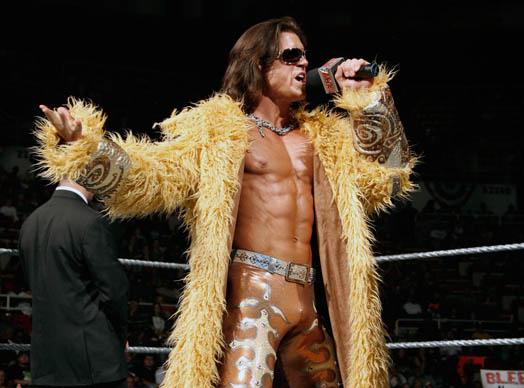
Take for instance, one John Morrison. After inexplicably becoming ECW Champion in 2007 (inexplicably, as he’d spent the past 6 months doing nothing but be scenery next to the heavily-pushed Melina), the then-Johnny Nitro underwent a makeover. Now instead of being a heatless pretty boy, he would now be a heatless impersonator of The Doors’ enigmatic frontman.
Gone were his seldom used Sunset Blvd/reality-show-brat witticisms, now replaced by melancholy musings and proclamations, delivered in a breathy and bored monotone. Essentially, he’d just become Raven with a washboard stomach, and little character motivation.
But Morrison was a skilled in-ring performer, as evidenced in his matches with CM Punk over the ECW Title. Supplementing his innovative gymnastic style was his improved promo work, becoming the understated half of a partnership with the bombastic Miz. Together, they got each other over, and were WWE’s best tag team from 2007-09.
Although Morrison, in the process, ended up ditching most of the Leaves-of-Grass somberness that defined his persona early on, his inspiring ring work and acquired showmanship came to define him more than being a second-rate crooner of “LA Woman.”
—-
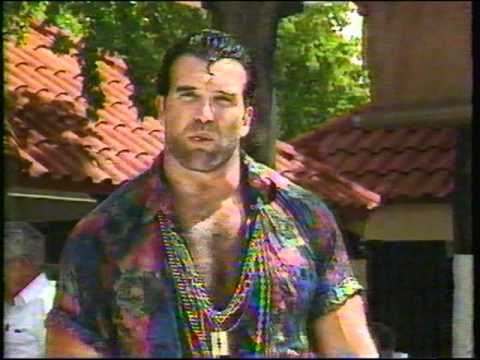
But Morrison wasn’t the only character ripped off of a pop culture icon. While Jim Morrison was a real-life figure, Tony Montana isn’t. The polarizing drug lord from the regarded 1983 classic film Scarface is imitatible, as Scott Hall proved nine years later with the role of Razor Ramon. Although Al Pacino, of Italian heritage, had no issues with a Hispanic accent, Hall’s attempt was a little more farcical.
Nobody had ever confused the decidedly-Caucasian Hall (from Minnesota) for being Latino, and the accent he employed would have been fine for a white guy like me going as Montana for Halloween. Even layering himself with tan after tan wasn’t going to fool very many people.
A lesser man may have died a quick death in the role, with the world never ‘being his’, but Hall had one thing going for him: sheer presence. Being 6’7″ with an arsenal of exciting power moves (namely his falling death drop, renamed The Razor’s Edge) was supplemented by his confident promos, whether threatening or playful. His natural swagger could have carried many gimmicks on this site to better days.
And to think, Razor Ramon was born when Vince McMahon suggested to Hall that he work as Sgt. Slaughter’s new recruit, Private Scott Hall. Hall suggested a “better idea”, asking Vince if he’d ever seen Scarface. Vince said he hadn’t, and an impromptu demonstration of Pacino’s revered character led to WWE saying hello to “The Bad Guy.”
—-

When WCW was acquired by WWE in 2001, I was delighted to see a few of my favorites cross over with their jobs in tact. Among the likes of Booker T, Lance Storm, and Diamond Dallas Page was WCW Cruiserweight Champion “Sugar” Shane Helms. Armed with a breathtakingly deadly finisher, The Vertebreaker, and a style similar to the popular Hardy Boyz (his real life chums), Helms was certain to be a hit in WWE.
But it wouldn’t come as “Sugar Shane”. After dropping the name “Shane” (can’t have two Shanes with Vince’s son around), Helms would undergo a dramatic repackaging. With the invasion angle foundering, and many of the crossover guys lacking identifiable gimmicks, Helms’ love of comic books came into play.
An innocent conversation with Alliance leader Steve Austin about Helms’ Green Lantern tattoo spurred Helms becoming a superhero himself. The Hurricane was born, bedecked in green and black, wearing a mask to hide his identity (*wink*). But the character was played as a goof who everyone rolled their eyes at, and often got manhandled by larger foes.
Despite that, Helms was a multiple time Cruiserweight and Tag Team Champion with the gimmick. His mask was a top seller at WWE Shop, and he played the role so over the top, he was more fun to laugh with as opposed to at. He even got a catchphrase out of it (“WASSUPWITDAT?”), and remains a memorable character in WWE’s annals.
—-
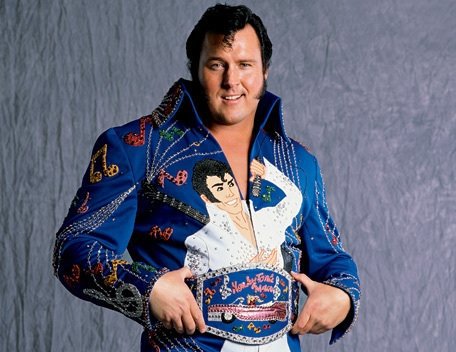
What about an Elvis impersonator? Surely, even though the wrestling world has had its share of kooks and cretins, that even someone looking and dressing like Memphis’ most famous son would be pretty dumb. Especially if you brought him into a company as a good guy alongside Hulk Hogan and Ricky Steamboat, and expected fans to get behind him.
That’s what WWE did, importing Roy Farris in 1986. Farris had competed as Honky Tonk Wayne prior to his WWE jump, but he, like many, made his greatest mark in sports entertainment’s titan. After getting a negative reaction for the first few months of his WWE run, the now-Honky Tonk Man became a villain, still in the Elvis garb. Good call.
Managed by Jimmy Hart (taking on a “Colonel” title, a la Tom Parker), Honky became an obnoxious punching bag for good guys like Jake Roberts to wail on. A big twist came in June 1987, when Honky upset mega-star Ricky Steamboat to become Intercontinental Champion. For the next fifteen months, nobody, from Steamboat to Randy Savage to Brutus Beefcake, could get the title off of him. Honky always managed to escape somehow.
And that was the beauty of the role. Honky was easily hateable, always thanking the fans for being a beautiful audience with no sincerity in his tone. House show revenue with Honky as IC champ was big, as fans lined up outside arenas, hoping to be the ones to see the cocky charlatan finally get beaten. Could another wrestler have played Honky Tonk Man quite like Roy Farris? It would be a daunting challenge.
—-
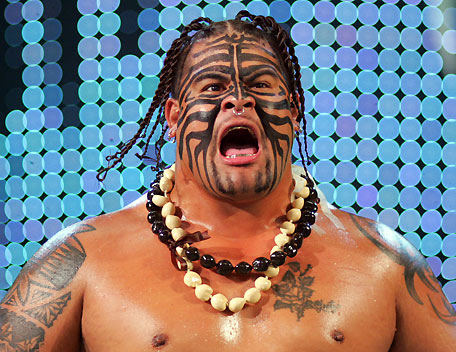
Over the years, WWE has cycled through the concept of the “dangerous island savage” gimmick, to the point where there aren’t many fans who would buy into it as realistic. While the likes of King Curtis Iaukea, Jimmy “Superfly” Snuka, and the Wild Samoans were successful in the days of wrestling yore, the gimmick seemingly died out with the Headshrinkers in the 1990s.
By 2006, the audience was much hipper to the room than it once was, thanks to the proliferation of wrestling news and history on the internet. WWE at the time was still marketing toward adults a little more, so it was a surprise when they decided to create a throwback character: Umaga, the Samoan Bulldozer.
Speaking no English and, well, bulldozing opponents between his incoherent screams, Umaga became a fixture on WWE Raw, even if reactions to him were a little lukewarm early. Umaga was the younger brother of Tama and Rikishi, who both played similar roles earlier in their careers, but those days had long since died out.
Umaga, however, found traction in two places. First, he made a great foil for John Cena’s Superman act, engaging in a violent feud with the champ, and looking like a real threat. Later, he became Vince McMahon’s dial-a-henchman. After he’d perfected his act as an unstable primal beast, he fit the bill perfectly, helping McMahon steamroll Bobby Lashley and anyone else the boss saw fit to destroy.
—-
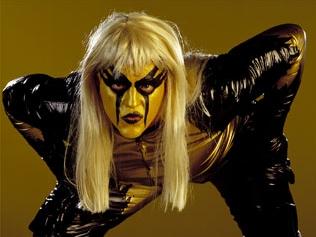
In 1995, Dustin Rhodes would make his WWE return after a fruitful four year run in WCW, earnestly adding to the championship legacy of his father, “The American Dream”, Dusty Rhodes. WWE at the time was much more circus-like than he remembered in 1991, and a zany gimmick was the order of the day. Little did anyone know how the weird idea for Dustin would come to identify him, in a very positive way.
Through a series of unsettling vignettes in Hollywood, Dustin transformed into Goldust, a heavily made-up thespian with theatrical darkness and heavily-implied homosexual overtones. It was a drastic change from the humble Texan he’d been playing for his whole career, and many wrote it off as just another ridiculous WWE cartoon character.
But the Goldust character had bite. By copping feels of his opponents, and displaying behavior not unlike a tortured artist with a cocktail personality, Goldust became known for his twisted mind games. Nobody in their right mind would have believed Dustin Rhodes could pull off this role, and none of those people could have probably even conceived it.
What seemed like a role tailor-made for WrestleCrap’s sorrowed halls actually became Dustin’s calling card, to the point where he would play it off and on through his WWE runs. This year, Goldust received a deafening ovation when he appeared at the Royal Rumble, engaging in fisticuffs with younger brother Cody. Explain that to anyone, even me, in 1995, and none of us would have believed it.
—-

Speaking of characters with camp elements to them, this brings discussion to Rico Constantino. You wouldn’t think a former police officer and American Gladiators contestant would lend himself well to a demeaning gay stereotype, but Rico put all of his energy into his role, having more fun with it than most wrestlers might have.
Rico debuted in WWE in 2002 as the “stylist” for another pair of faux flames in Billy Gunn and Chuck Palumbo. Defined by his muttonchops and a prissy attitude, Rico would leave the duo for Three Minute Warning later in the year. By spring 2003, the trio had gone their separate ways, and Rico was left with nothing to do.
That summer, Rico camped his image even more, borrowing pages from underappreciated legend “Exotic” Adrian Street. Now wearing more make-up and frills, Rico was accompanied by Jackie Gayda and put forth as a singles star. That had minimal success, and Rico was merely a bit player until he and Jackie were traded to Smackdown in 2004, when the former cop went for broke with the gimmick.
Now paired with the straight-laced Charlie Haas, Rico mashed every stereotype button possible, groping opponents (including asking Rikishi for a stinkface, and begging a reluctant D-Von Dudley to headbutt him in the crotch) as a means of getting in their heads, and making them susceptible to defeat. The fish-out-of-water duo proved popular, and Rico’s antics proved highly entertaining.
—-
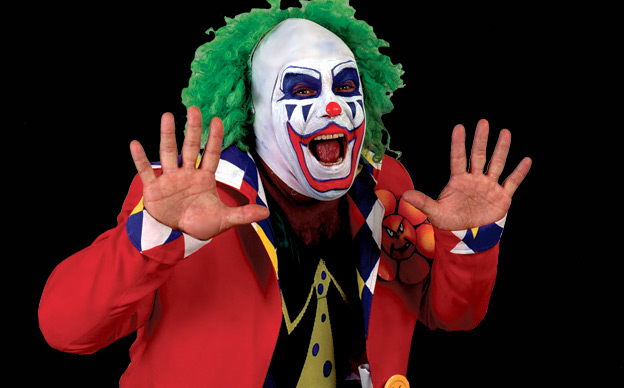
Of course, one can’t discuss WWE’s circus-like atmosphere without mentioning the resident clown. In the fall of 1992, Vince McMahon brought veteran Matt Borne into the fold. But instead of being plain ol’ Matt Borne, he was broached with the task of playing the evil and twisted Doink the Clown. Borne admitted in an interview that he was taken aback, but says Vince insisted that he thought only Borne could pull it off.
After studying Tim Curry’s performance as Pennywise in Stephen King’s “It”, Borne cloaked himself in the grease paint and became a mean-spirited bozo who tormented fans, and pulled pranks on wrestlers. His first big angle was attacking Crush with a fake human arm filled with batteries and lead, after faking an apology to the big Hawaiian.
But unlike a lot of WrestleCrap gimmicks, Doink the Clown (as a heel) had more than one layer to it. While he was, indeed, a deranged harlequin, he was also a skilled wrestler, something Bobby Heenan would always point out, and Vince McMahon and Randy Savage would begrudgingly concede. It seemed the clown schtick was merely a distraction to the opponent before they were blinded by his masterful wrestling and ring generalship.
Doink would have great matches with Savage, Bret Hart, Marty Jannetty, and Mr. Perfect, alternating between his twisted antics and dominant grappling with a hint of bi-polar tendencies. It’s hard not to admire the way in which Borne took a silly idea and played it in a way that requires timing, presence, and his own spark of madness.
—-
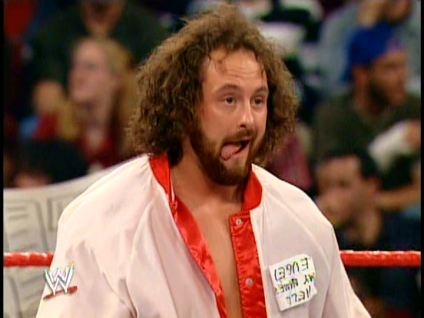
Just look at that picture. Look at it long and hard. There is no conceivable reason that Nick Dinsmore’s run as Eugene, the nephew of Eric Bischoff, should have been spared a trip to RD Reynolds’ induction gallows. Unless, of course, you remember how Eugene was originally presented to the audience. In which case, it was a gimmick with so many possibilities, and of course WWE squandered them.
The fact that Dinsmore was a skilled wrestler that had taken Chris Benoit to the limit when Benoit visited OVW several years before was vital to the role. Instead of simply being a slobbering dimwit who fans should feel sorry for, Eugene was a savant. He had watched wrestling his whole life, and had an encyclopedic knowledge of wrestling holds as a result.
Eugene began his WWE tenure with Bischoff assigning an indignant William Regal to be his handler. Regal wanted to rid himself of the well-meaning nuisance, and tried to torture him in a wrestling training session. Instead, Eugene outwrestled him, giggling all the while, and gradually won Regal’s love and respect.
By the time Eugene had made his in-ring debut, he was a star. Although his slow intellect would be his Achilles heel, he would compensate by ravaging opponents with moves that hadn’t been seen in years, making him dangerously unpredictable. He was never the same after Triple H got the better of him, and played a broader stereotype of the mentally challenged going forward, thus robbing the gimmick of its appeal.
—-
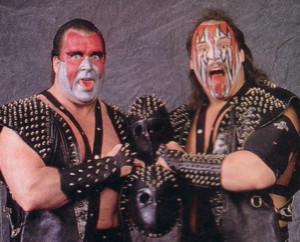
Longtime WWE fans might have a hard time believing that Demolition would fit WrestleCrap’s criterion, and for the most part, they certainly didn’t. Ax and Smash deserve their place among WWE’s greatest tag teams ever, and lived up to their name during their heyday from 1987 to 1990. But it wasn’t always the company’s intention that they would be used in their dominant capacity.
When they debuted in early 1987, Ax was pushing 40 (after wrestling for years as Masked Superstar) and Smash was played by Randy Colley, better known as Moondog Rex, who wasn’t much younger. They were covered in much more garish and laughable face paint, and actually had glitter in their hair. The original appearances of the Demos actually were inducted into this site.
It seemed as though the team was just a petty joke at first, meant to ridicule the Road Warriors in the NWA after Vince was unable to give them the guaranteed contracts they wanted in the mid-1980s to jump ship. But when Barry Darsow (a friend of Animal and Hawk’s) took over the role of Smash weeks after the debut, the team hit it big.
Demolition became known for their catchy Sabbath/KISS-sounding hard rock theme, their convincingly brutal offense, and their equally-convincing caustic promos. The fans essentially turned them face by cheering them often, and they parlayed this winning formula into three tag team title reigns, one of which lasted from March 1988 to July 1989.
—-
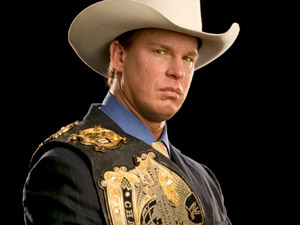
The image above was maddening to many a fan in 2004. When little-regarded tag team wrestler Bradshaw transformed into John Bradshaw Layfield in the spring of that year, essentially mixing Stan Hansen and Ted Dibiase into one persona, nobody was buying the career midcarder as a threat to Eddie Guerrero, Undertaker, or any other main event player. This was a man who traded the Hardcore Title with Johnny Stamboli, mind you.
But JBL, a financial guru in real life whose made many appearances on FOX News and FOX Business, cultivated this deeper persona, as if his life and career depended on it (the latter for sure). He was pushed over Guerrero to become WWE Champion in June 2004, and he’d hold the gold for over nine months. Smackdown PPV buyrates dwindled in 2004 with him on top, something his detractors mentioned often.
Hindsight was much kinder to JBL, as fans who refused to buy into him as a main eventer grew to appreciate his willingness to make any babyface look good. JBL willfully played the coward, displaying a never-before-seen wit that ranged from exaggerated to subtle, and became one of the most entertaining members of the roster.
In retirement, he’s been a welcome change of pace in the commentary booth, calling out Michael Cole for his inconsistencies, and providing insight and knowledge that Jerry Lawler can’t be bothered to add. When he was “Bradshaw pretending to be Dibiase”, he was boring, but when he fused his natural personality into the role, JBL worked out well.
—-
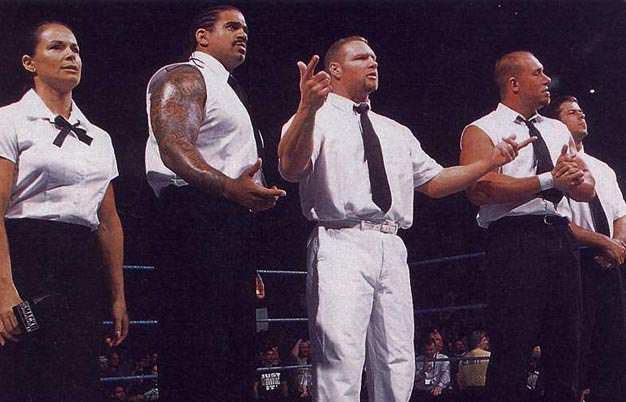
WWE has never been a company to shy away from hitting back at its critics. Whether it’s been Vince McMahon giving editorials against Phil Mushnick on his weekend programs in the 1990s (solely in the New York market), or using Jillian Hall to mock Brooke Hogan’s singing after Vince and Hulk Hogan had a falling out in 2006, Vince is known for being childish at times.
So it’s no surprise that WWE spoofed the Parents Television Council (PTC) in 2000 with the Right to Censor (RTC). The PTC was a conservative group that championed decency in television programs, and labeled WWE’s Attitude product to be the antithesis of family programming. The PTC urged WWE’s sponsors to boycott the product, and that led to WWE making Stevie Richards over into a zealot like L. Brent Bozell.
While much of WWE’s booking that’s used to spite someone instead of entertain fans would be grounds for induction, the RTC drew massive heel heat. The Godfather and Val Venis joined the cause, abandoning their risque personas to “fight the good fight”. Add Bull Buchanan as muscle, and Ivory as shrill female presence, and you have a very hateable group.
During their run of censoring female nudity and sneak attacking the likes of the Dudley Boyz and Chyna, they made it easy for faces to get over at their expense, which is the hallmark of any good villain. They were largely vanquished by the time Wrestlemania X7 came to an end, and that meant the end of their appropriately annoying theme song as well.
—-
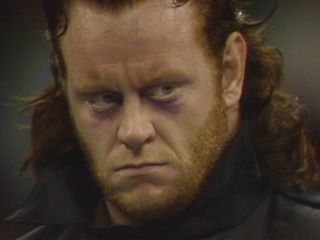
Likely nobody would have guessed that the same “Mean” Mark Callous that jobbed to Lex Luger’s clothesline in 1990 would become the most enduring character in WWE history. And nobody in 1990 believed he would do it while playing a zombie mortician that was nearly impervious to pain. Had anyone other than Mark Callaway taken on the role of “The Phenom”, there’d probably be no ‘streak’ and no legend to speak of.
Countless entries onto this site have been menacing characters, meant to instill fear in the hearts of opponents and fans alike. While they failed, The Undertaker succeeded by being downright frightening. His cold, unblinking stare was complimented by his chilling movements that were less walk and more stalk. Framed by Jim Johnston’s rendition of the Funeral Dirge, and The Undertaker was a winner.
In spite of the ridiculous moments his character has endured, like the feud with Giant Gonzalez, his levitation at the 1994 Royal Rumble, and his involvement with the Ministry of Darkness, Undertaker has soldiered forward, his reputation never taking a hit. When you master a difficult character and leave an indelible mark on the fans the way he has, you tend to get lots of leeway.
It does speak volumes that, for 22 years and counting, The Undertaker has been a main eventer player, one almost always welcome, never out of place, and he’s done it playing a character virtually nobody else could play without looking foolish. For these reasons, The Undertaker might just be the greatest gimmick of all time.


